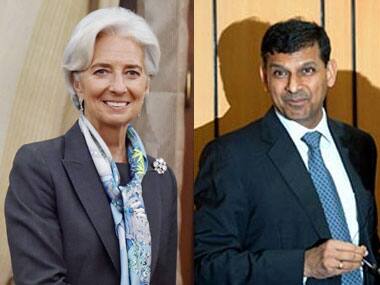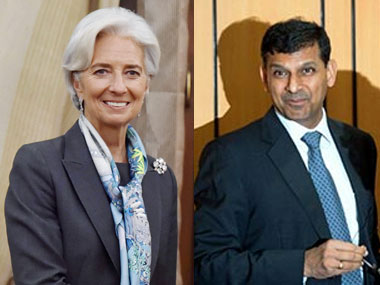Christine Lagarde, managing director of International Monetary Fund (IMF), appeared largely convinced about the good state of Indian economy when she delivered a speech at the Reserve Bank of India (RBI) on Tuesday. Lagarde showered praises to almost everyone among Indian policymakers - from RBI governor Raghuram Rajan to prime minister Narendra Modi. Lagarde spoke of India “shining brightly” among the emerging markets, complimented Rajan for steering the Indian economy to “safer waters” and praised Modi for his ambitious financial inclusion programme, Jan Dhan Yojana, under which crores of bank accounts were opened in a short span of time. But then came the caution. [caption id=“attachment_2159777” align=“alignleft” width=“380”]  PTI[/caption] Lagarde said fast-paced financial development in an economy could offer more harm than positives. According to the IMF chief, deepening of financial institutions, when “done too fast” can lead to economic and financial instability. “The experience of advanced economies has shown the dangers that can arise from oversized financial systems,” Lagarde said. Fast-paced development of institutions, Lagarde said, “encourages greater risk-taking and high leverage, particularly when poorly regulated and supervised.” This caution is particularly relevant for India, where concerns of financial systems growing much faster in relation to the size than the overall economy. Oversized financial institutions Like oversized financial systems, problems arising out of oversized financial institutions too have been highlighted by the Indian policymakers in the past. This was in the context of widening gap in asset sizes of the largest bank (State Bank of India) and the rest of its competitors. In August, 2013, former RBI governor, D Subbarao, had raised this issue. “Presently, (there is) significant skewness in the size of banks. The second largest bank in the system is almost one-third the size of the biggest bank. This creates a monopolistic situation,” Subbarao had said. The reason why policymakers were worried about the ‘oversized’ financial institutions is that if something goes wrong with them, this can have serious ramifications on the whole financial system. Developed economies of the world have had their share of woes from too-big-to-fail financial institutions. Probably, this is something that might have prompted the US federal reserve to finalise a rule in November last year that prohibits any financial company from acquiring another, if the resultant entity’s liabilities exceeded 10 percent of the total liabilities of the financial services system. The new rule - Section 622 of the Dodd-Frank Wall Street Reform and Consumer Protection Act - says once a particular entity reaches the specified concentration limit, that bank cannot acquire control of another entity. Logically, the new rule intends to shield the US financial system from the foibles of ’too big to fail’ banks, which could then spark a crisis like the one in 2008 following the collapse of Lehman Brothers, which triggered a global financial meltdown. That meltdown showed that when banks become too big, they can bring down the whole financial system when they lend or invest imprudently. In India too, the RBI is doing the ground work to identify and regulate systemically important financial institutions. In July, it released a framework to identify domestic systemically important banks (D-SIBs) and said four to six banks could come under this category. The idea is to bring such entities under “differentiated supervisory requirements and higher intensity of supervision”. Banks having a size beyond 2 percent of gross domestic product (about Rs 2,60,000 crore) will be considered to be part of this category. If one applies this size formula, at least 13 banks will fall under the D-SIB bucket. These include State Bank of India (SBI), Bank of Baroda, ICICI Bank, Bank of India, Punjab National Bank, Canara Bank, HDFC Bank, Axis Bank, Union Bank, IDBI Bank, Central Bank, Indian Overseas Bank and Syndicate Bank. To be sure, size alone wouldn’t make these entities D-SIBs. The RBI would also consider their interconnectedness, substitutability and complexity for that. On the other hand, if one goes by the Fed formula, i.e., deposits or liabilities equal to 10 percent of the system, SBI would be the only bank to come under this definition. It would be restricted from adding further liabilities and monitored more closely. Most other bigger banks will come much below this trigger on a standalone basis, even though any possible merger involving large banks such as Bank Baroda, Bank of India, Punjab National Bank and Canara would result in entities that will have liabilities over the Fed’s threshold. SBI, which has assets of Rs 19.04 lakh crore as of 31 December 2014, is nowhere among the top lenders in the world. But for India’s Rs 89,00,000 crore banking sector, SBI is T-Rex. Going by asset size, SBI is nearly thrice as large as the next bank BoB, which has asset size of about Rs 6.57 lakh crore as of 31 December 2014. Also, SBI had a deposit base of Rs 15.10 lakh crore, which is about 17.8 percent of the total deposits of the whole industry. That’s not all. SBI is on course to even grow its liability size by merging its associates with itself. Of the seven associate banks, two - State Bank of Saurashtra and State Bank of Indore - were merged with SBI in 2008 and 2009, respectively. According to the government’s stated roadmap, the larger plan is to merge the remaining five subsidiaries with the parent entity. These are State Bank of Bikaner and Jaipur, State Bank of Hyderabad, State Bank of Mysore and State Bank of Patiala. If one takes the whole SBI group’s liabilities even at this stage, the share of deposits to the total industry stands at a huge 23 percent as of June. To be sure, there is no rationale in comparing the US banking system with the Indian banking industry. The total assets of US banks are more than 10 times that of Indian banks. Clearly, Indian banks are midgets in comparison to US counterparts. But Lagarde’s caution on oversized financial systems in relation to the economies they exist very much applies to the Indian context — both in the context of fast growing banking system and the widening gap among its large financial institutions. Clearly, Rajan can take a lesson or two from IMF chief’s warnings to avert a repetition of west-like financial crisis.
Clearly, Rajan can take a lesson or two from IMF chief’s warnings to avert a repetition of west-like financial crisis.
Advertisement
End of Article


)

)
)
)
)
)
)
)
)



